Take the Test!
Look at the color tabs and pick out the first color that you feel is closest to your heart. Do you like blue, green, orange or gold? Hold that thought!
Before I explain the meaning of your color, here is something that you need to know about this psychological test.
Why you need to know your “True Color”
The question of “Why do I need to know my True Color?” is pretty much the same as “Why do I need to know myself?”.
The True Colors test, like other psychological tests, is one way of building self-awareness. It brings our distinct but often disregarded traits, mannerisms, and behaviors to the surface where we need them for checking. In a classroom, office or a setup where other people are involved, it is important to know how we act and react towards harmony or conflict with others. In fact, even in a relationship, a personality test can come in handy for both parties. This way, a harmonious environment if not a “war-free” zone can be arranged.
Self-discovery is only one of the many benefits, like unlocking your potentials, unearthing your weaknesses, realizing your bad habits – and knowing if you really are normal or not. Nowadays, companies spend a lot for personality testing just to get to know their new hires and possibly future employees. These evaluations are based on their three main concerns; your skills, your drive, and your ability to work with others. Presently, there are about 2,500 questionnaires for testing that in 2009 alone, the industry of Personality Testing cost $5 million. It doesn’t stop there as costs increase by 10% annually. So imagine just how much people are spending just to get to know you. How much will you spend to know yourself?
For real…
You don’t have to spend that much. However, be informed that as easily accessible online tests are, they are not guaranteed to be accurate. One reason comes from the fact that we could be dishonest with answering questions at times. This test is quick, easy, and if you know the basic meanings, you don’t need to pay for supervised True Colors tests to get your results.
A Brief Trip to Memory Lane
The earliest personality casting is “The Four Temperaments” by Hippocrates. It was later on adopted by Professor Hans Eysenck, Ph.D (1916-1997) in his own theory. Hippocrates believed that the four bodily fluids; blood, yellow bile, black bile, and phlegm are all blood, which change color and consistency upon extraction from the body. These fluids, or “humors”, were associated to corresponding colors and to an appropriate temperament. Red is for the Humor of the Blood – the Sanguine (amorous), Yellow is for the Humor of Yellow Bile deposited in the gall bladder – the Choleric (short-tempered), Black is for the Humor of Black Bile found in the spleen – the Melancholic (sentimental) and Green for the Humor of Phlegm – Phlegmatic (sluggish).
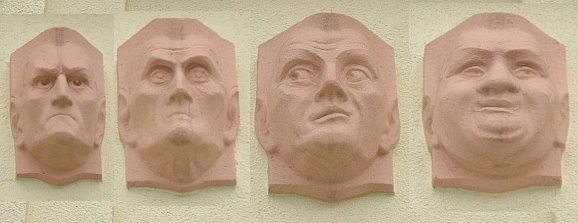
The four temperaments – (L-R) choleric, melancholic, sanguine and phlegmatic – on the wall of a house at the corner of Am Dornbusch and Eschersheimer Landstraße in Dornbusch, Frankfurt am Main, Germany. Artist unknown. The picture is a composite of four close-ups. by Peng, via Wikimedia Commons
Basing from the Classic and Greek study of The Four Humors, Professor Eysenck expounded these traits, focusing even more on the psychological aspect. His Personality Casting is widely accepted and further dissected and innovated to several personality typology.
It was Don Lowry who, inspired by his predecessors, formulated the easier True Colors Test in 1978, after following the inspiration of “Please Understand Me” author David Keirsey. Keirsey merely simplified the more complicated psychological typology by Carl Jung, Catherine Briggs, and Isabel Myers but it was Don Lowry who simplified it. In addition, Lowry’s technique of presenting four color cards became a means of entertainment, thus making the atmosphere for evaluation a bit more relaxed. This way patients or clients didn’t need to feel uneasy being examined.
The Color Meanings and their Quirks
I don’t claim to be an expert in Psychology but I have encountered this activity during a Team Building event and saw how effective it was on me. Later on, when I was graciously moved up in the company i worked for, I tried it on my group to know more about them. With the basic meanings to guide me and several references as second opinions, I appreciated how easy it was and how useful it could be. Today, I still use it. Other companies can use the True Colors Test to evaluate an individual or an applicant. It is also very useful for a group in leadership training, collaborative activities and many more.
Moving on, if you have chosen your color, let’s see if it agrees to your personality.
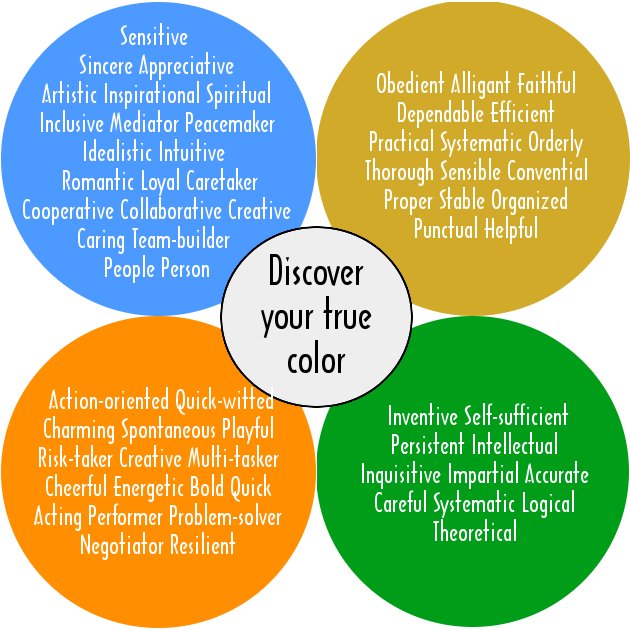
BLUE
When we say color BLUE, the immediate images that come to mind are those that speak of calm and tranquility. Blue Color Personalities are known as the “artists” in the True Colors typology. In addition, since they are the sensitive ones, the peace-bringers, the mediators, they are the “nurturers” among the Color Personalities. It is a primary color that mixes well with other colors, the same is true for the Blue Personality, where they usually bring balance and harmony. Since it is the least gender-specific and both men and women find comfort in the color blue, it isn’t surprising that a significant number of people will choose blue over their True Color, This means, mental reflexes choose blue because it is the most unconsciously desired psychological state. The things that easily frustrate them are lying, violence, self-rejection, the lack or absence of friends and communication, and sarcasm. Their known negative traits include lack of planning, being passive, avoiding conflict, suppressing problems, being overly sentimental and being overly generous. If you cannot relate to these then that means impulse led you to blue, so you may want to examine the next color. By the way, Gandhi and Mohammed Ali are popular Blue Personalities.
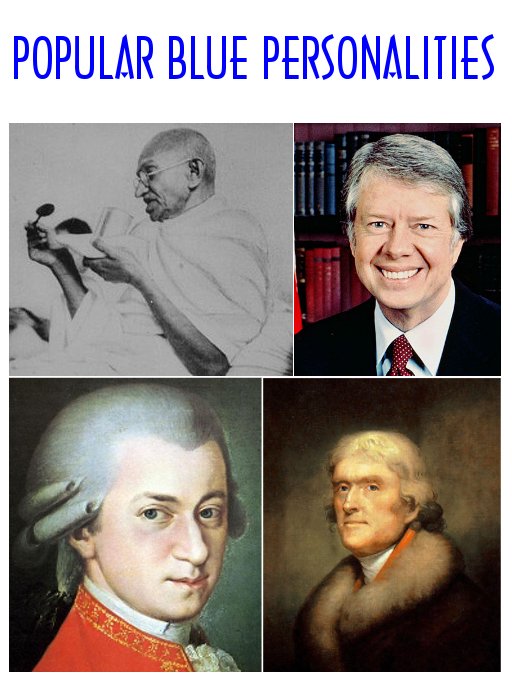
The artists, peace bringers and the sensitive ones
GREEN
A famous Green Personality character is Benjamin Franklin. Like him, Greens are “visionaries”. These people are motivated by anything that is “logical”. The psychology of the color green immediately suggests wealth in terms of money and imagery of trees and natural greens. This explains why most Green Personalities choose conservative careers in Business, Mathematics and the Sciences. They don’t like routine, being small-talked, plagiarism, incompetence, having to argue without sense or reason and having to attend social activities. On the contrary, they are likely to irritate others with their inability to accept criticism, inability to be sociable, being too wordy and then being too independent which means they have a mind of their own and will not likely go with the flow.
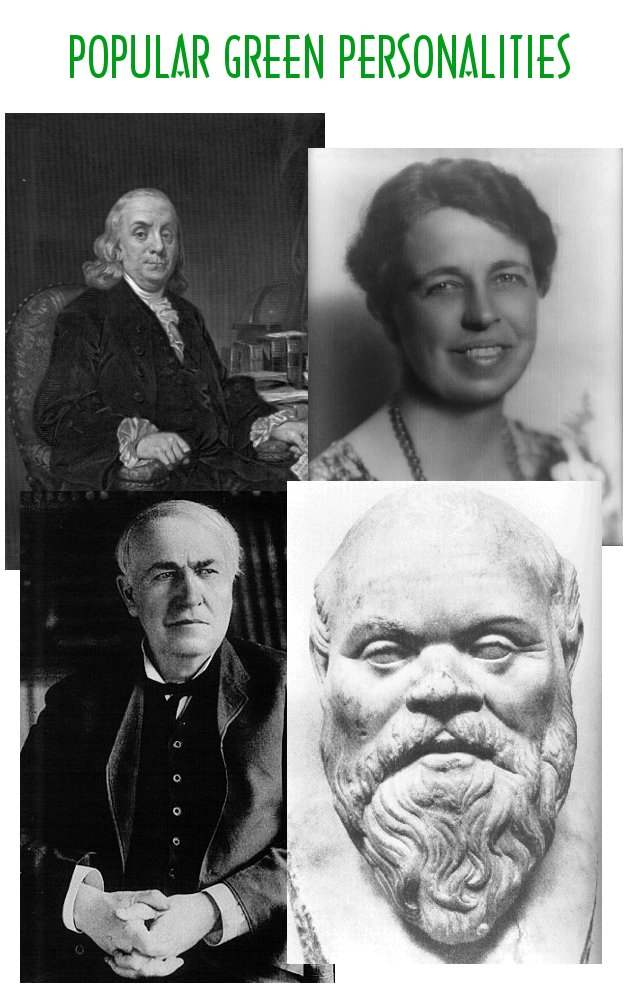
The Visionaries
ORANGE
They ignore rules and can come across as undisciplined. They have quick tempers, often think out loud, aren’t likely to plan and because of that and they are impulse buyers. Orange Personalities can be easily told off from other personalities and they are the easiest to identify. At first glance, it looks like red. Of course, orange was derived from the passionate blood color so it shares that sort of vim, expanding to the energy that is Orange. Color psychology relates orange with ambition. Orange personalities are the life of the party, of adventure, of extremes, of movement and desire for freedom. That is why they don’t like rules, laws, routine, deadlines, paperwork, too much structure and the lack and especially the absence of adventure. As impossible as Oranges may seem sometimes, their charisma and quick-wit keeps them off trouble. Did you know Winston Churchill and JFK were Orange Personality types?
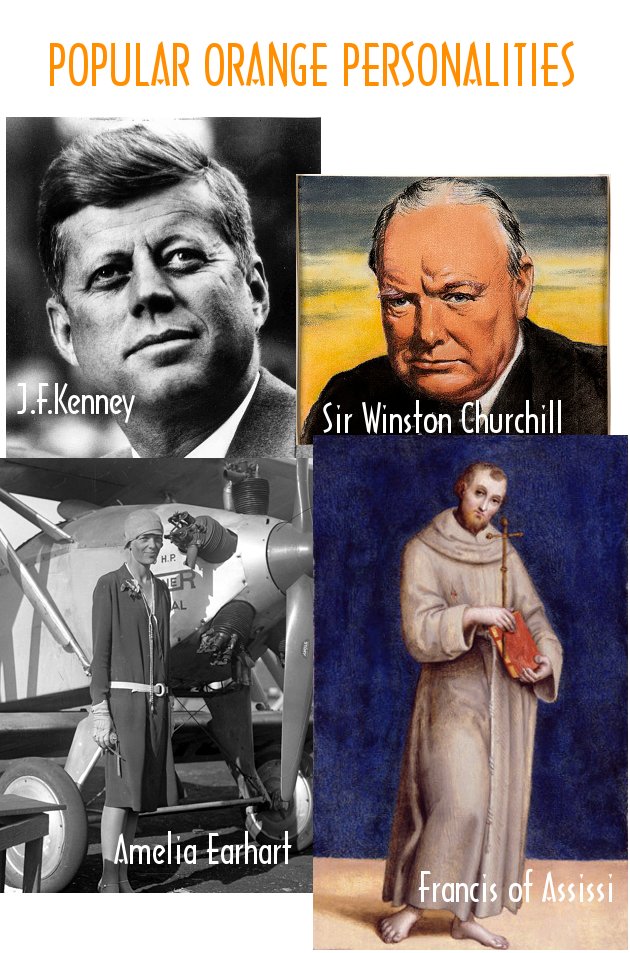
The action-oriented, quick witted and problem solver group
GOLD
The “traditional” gold is exemplified by the likes of Mother Teresa and George Washington. They value all things organized, structured, and disciplined. For their love of what is right and proper, they don’t like irresponsible, undisciplined people who lack planning, laze about, take great risks, and people involved in illegal activities. These personalities do not go well with Orange personalities. Gold personalities are commonly identified as being bossy, control-freaks, people who work long hours, obsessive, judgmental, and people who plan for everything. However, while they are a threat to conflicting color personalities, society still needs them. With their systematic approach and high consideration for work before play and family after work , they are the esteemed parent-image of other personalities.

The organized, structured and disciplined ones
If you ask me…
Personally, I am a little bit of everything. When I was a child, I was a fun-loving Blue. My teenage years were my adventurous Orange moments until I took up a course in college, which made me a logical Green. Now that I run my own company and have kids of my own, I have become the responsible Gold. Those are my “True Colors”. What’s yours?
Photo credit:
Socrates – by Magnus Manske at en.wikipedia Later versions were uploaded by Optimager at en.wikipedia.org.
Individual photos of well known figures are taken from [Public domain], from Wikimedia Commons